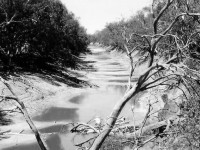The Division of Water Rights is the state agency that regulates the appropriation and distribution of water in the state of Utah. It is an office of public record for information pertaining to water rights, excepting that related to water right ownership. The office of public record for water right ownership is the county recorder’s office for the county(ies) in which the water is diverted. All official and publicly accessible water right records are available in the Salt Lake City office or from this site. Region Offices outside Salt Lake City will also have copies of most records for the areas they administer.
The Utah pioneers, in the late 1840’s, were the first Anglo-Saxons to practice irrigation on an extensive scale in the United States. Being a desert, Utah contained much more cultivable land than could be watered from the incoming mountain streams. The principle was established that those who first made beneficial use of water should be entitled to continued use in preference to those who came later. This fundamental principal was later sanctioned in law, and is known as the Doctrine of Prior Appropriation. This means those holding water rights with the earliest priority dates, and who have continued beneficial use of the water, have the right to water from a certain source before others with water rights having later priority dates.
In the early territorial days, rights to the use of public streams of water were acquired by physical diversion and application of water to beneficial use, or by legislative grant. A “county courts” water allocation system was enacted in 1852 and was in effect until 1880 when it was replaced by a statute providing for county water commissioners.
The Office of the State Engineer was created in 1897. The State Engineer is the chief water rights administrative officer. A complete “water code” was enacted in 1903 and was revised and reenacted in 1919. This law, with succeeding complete reenactments and amendments is presently in force mostly as Utah Code, Title 73. In 1967 the name of the Office of the State Engineer was changed to the Division of Water Rights with the State Engineer designated as the Director, but the public sometimes still refers to the Division as the State Engineer’s Office.
All waters in Utah are public property. A “water right” is a right to divert (remove from its natural source) and beneficially use water. The defining elements of a typical water right will include:
A defined nature and extent of beneficial use;
A priority date;
A defined quantity of water allowed for diversion by flow rate (cfs) and/or by volume (acre-feet);
A specified point of diversion and source of water;
A specified place of beneficial use.
Rights for water diversion and use established prior to 1903 for surface water or prior to1935 for ground water can be established by filing a “diligence claim” with the Division. Such claims are subject to public notice and judicial review and may be barred by court decree in some areas of the state.
All other rights to the use of water in the State of Utah must be established through the appropriation process administered by the Division of Water Rights. The steps to this process for an “Application to Appropriate Water” are as follows:
An Application to Appropriate Water is filed with the Division.
The application is advertised and protests may be received and a hearing may be held.
The State Engineer renders a decision on the application based upon principles established in statute and by prior court decisions.
If the application is approved, the applicant is allowed a set period of time within which to develop the proposed diversion and use water. When the diversion and use are fully developed, the applicant retains the services of a professional engineer or land surveyor who files “proof” documentation with the Division showing the details of the development.
Upon verification of acceptably complete proof documentation, the State Engineer issues a Certificate of Appropriation, thus “perfecting” the water right.
Many areas of the state are administratively “closed” to new appropriations of water. In those areas, new diversions and uses of water are established by the modification of existing water rights. Such modifications are accomplished by the filing of “change applications.” These applications are filed and processed in a manner very similar to that described above for Applications to Appropriate Water.
Water appropriation issues in specific geographic areas of the state are often administered using policies and guidelines designed to address local conditions. These policies and guidelines are generally developed for all or part of a defined Drainage Basin.
For help with your Water Rights Case Contact Jamie Carpenter Today >>


